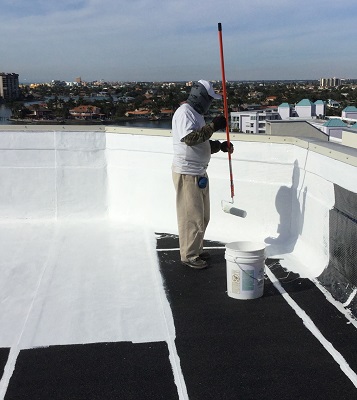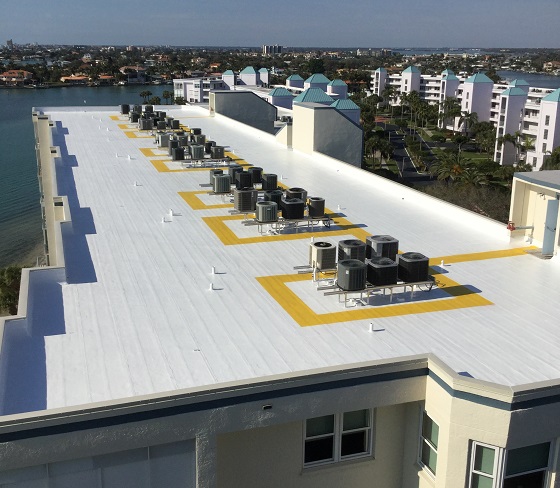Coating roofs on a condominium can be tricky. There are obviously tenants, concerned with not only odors and sounds, but they can also be intrigued by what’s going on topside. (Who wouldn’t want to take a look?) There is the question of how and when to access the jobsite through someone’s home. And then you have to combine all of those with the general issues of safety, specifications, and warranties. That certainly has the potential for one complicated project!
On this South Pasadena, Florida, condo project, there were two 20-year-old roofs, compounding the situation. Luckily, this isn’t the first roofing rodeo for Unicoat Industrial Roofing Corporation. The eight-man crew working on the six-story-high roofs had been a part of the coatings company for nearly 15 years. According to Dave Kessler of Unicoat, they are “just first class, good guys.”
There were a few leaks, but in general, the roofs were in “very good condition,” according to Kessler. “The existing system really had no moisture, so it wasn’t wet or saturated as far as issues with it,” he said. After a third-party consultant named A.L. Freedman tested that moisture using core cuts and a nuclear scan, the client was given the all clear to coat the roof. But even with the stage set, it was Unicoat’s attention to detail and understanding of the unique circumstances that proved to be crucial.
Zebra Stripes
At the jobsite, only 20 minutes from the crew’s home base, Unicoat was granted access to its own elevator. They also used a crane to move all equipment and materials up top, marking off that ground-based crane area. Despite a great setup, the crew still used additional protection for the marble flooring downstairs, concrete areas outside, and carpeted exteriors up top.
 They also had a designated area for trash, since they trucked all disposables back to their office’s Dumpster via trailers or Ford F350s. That included loose granules from the old modified bitumen (mod bit) roof, which the crew collected after pressure washing with 4,000 psi (27.6 MPa) machines from Mi-T-M. The crew collected the loose granules with brooms and some 5-gallon (18.9 L) buckets before the water could go down the drains. They followed that up with another pressure washing, sending out a three-person team to get started on the second roof while the rest of the team began priming.
They also had a designated area for trash, since they trucked all disposables back to their office’s Dumpster via trailers or Ford F350s. That included loose granules from the old modified bitumen (mod bit) roof, which the crew collected after pressure washing with 4,000 psi (27.6 MPa) machines from Mi-T-M. The crew collected the loose granules with brooms and some 5-gallon (18.9 L) buckets before the water could go down the drains. They followed that up with another pressure washing, sending out a three-person team to get started on the second roof while the rest of the team began priming.
Although rain wasn’t too much of a problem during this time of year, the crew did encounter about a week of wet weather. “They chose to do it out of the rainy season, so we didn’t really have any issues with the rain,” Kessler said. Moisture is actually helpful when applying the silicone coating. “We really didn’t have to worry that much, but did have to go over a dry substrate,” he continued. That meant waiting until the roof was dry to start spraying on the first coat, Aldo Products’ ALDOPRIME 708 Bleed Blocking primer, which was applied with a Graco 933 pump at an average of 1 gallon per 100 square feet (3.8 L per 9.3 m2). “We’d meet every couple days just to go over the safety, the equipment, making sure we had the right hoses, making sure the right pressure and all that stuff, so that’s something we’d watch,” Kessler continued.
According to Kessler, the primer is used for two reasons: “One, it prevents the oils in the asphalt that are in the existing roof from coming up through the white coating. And it also allows for better adhesion for the silicone coating, so it gives you a really nice tacky surface.”
Another twosome on this project, the crew used two methods to ensure that they were installing coatings at the right thicknesses. Kessler explained, “We do it with a wet mil tester as we’re putting the product down, then we also grid the roof off so know exactly how many gallons should be used in each area.”
After the primer went down, the crew sealed all curbs, flashing, and seams, the latter of which were located about 4 feet (1.2 m) apart due to the width of the mod bit rolls. They brushed on a layer of ALDOSEAL 399 Silicone Sealant on the seams. “It almost looked like a zebra,” Kessler said.
Early Bird
The four-week-long project concluded with the silicone topcoat, applied in one go to achieve an average thickness of 2.5 gallons per 100 square feet (9.5 L per 9.3 m2). The crew worked between the hours of 8 a.m. and 4 p.m. “We tried to get in there in the morning before everybody started to come out,” Kessler said.
According to Kessler, a big benefit of the high-solids silicone is its minimal odors. “That’s an advantage to the residents too; it’s not like they’re going to have a high solvent odor compared to urethanes or some of the other products that are out there that get into the air ducts and you want to close them off. Because once they get in there, the units inside can really start smelling of high solvent-y type odors.” Despite that, some of the sprayers did choose to wear respirators.
They didn’t need to use fall protection because of those parapet walls, though. Instead, they used perimeter markings where the walls were lower. Around those edges, they also had to be careful when spraying the primer.
“When we got to the edges, we used the shields so it wouldn’t blow off the roof. And we’re very careful,” Kessler explained. “If it’s real windy, we just wouldn’t spray that day and that’d be a day when we’d do something else — maybe seams or something else. And then if it was a good day and we could spray, we’d start spraying.”
The crew tethered any loose hand tools to themselves, so they wouldn’t fall to the ground down below. “We followed all the OSHA [Occupational Safety and Health Administration] regulations and all the safety regulations from the permitting department, too,” Kessler said.
They got no complaints from the client or tenants, but they designed their plan to get those results. “We would do an overall safety talk,” Kessler said. “It was a combination that would be about safety and then also care around the residents to make sure everybody understood that people live there, that’s their homes, and try to be as quiet as we can, there’s no radios, we just monitor everything.” The goal was to be heard as little as possible, and they succeeded. “There were no issues at all,” he continued.
Warranty Awarded
After A.L. Freedman came through again, Unicoat was able to give the client a 15-year warranty for the roof at about a third of the price of a complete reroof. “Each roof they actually do about eight cut slits where they make cuts in the existing roof, they put in a package, they mark it, they take a picture, we seal up where they cut it, then they mail that off to manufacturer, and then they measure the millage to make sure it meets the specification for warranty,” Kessler explained.
The crew overshot to 40 mils (1,016.0 microns) to get their desired thicknesses, and it paid off. “I needed over 30 dry mils [762.0 microns] to get the warranty, and I think we averaged 34 dry mils [863.6 microns],” Kessler said.
With about 18 more roofs on the condo’s property, the sky could be the limit for this project. Unicoat has been back on site since and expects to continue to work with the owners. “They’re very happy with us,” Kessler said. “Everything was good.”
